- 650mm scale length
- Nut: 52mm
- Neck width at nut: 52mm
- 80 year old Brazilian Rosewood (pre-CITES) back and sides (Quartersawn).
- European spruce top
- Cedar neck
- Brazilian Rosewood headstock overlay, and bridge
- Brazilian Rosewood body binding, top and back
- Ebony fingerboard
- Sloane tuners
- Nitrocellulose lacquer finish
-
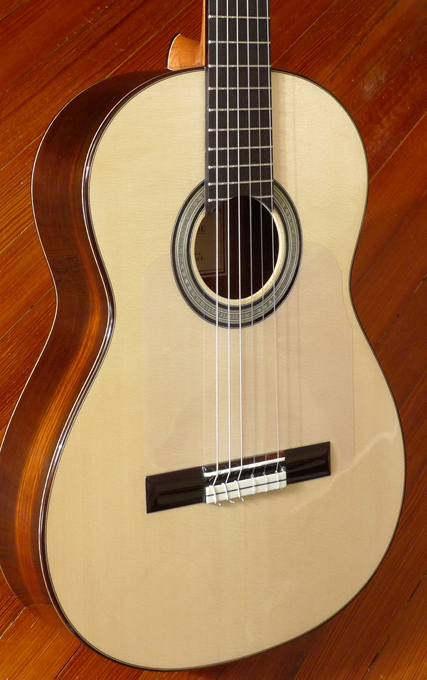 This new, custom made Lester Devoe Flamenco Negra is amasterpiece, from one of the world’s top luthiers. Lester Devoe needs nointroduction to the world’s great Flamenco players. The late, legendary Sabicasplayed a Devoe– and converted some of the great Flamenco players in Spain tothe fold. Paco De Lucia, and Vicente Amigo, among others, play Devoe Flamencoguitars. Paco De Lucia began playing a Devoe Negra guitar years ago– and thereare many Paco De Lucia recordings and feature films where Paco plays a DevoeFlamenco guitar.) This is the second custom guitar, that Lester has made for uswith select, old growth, quartersawn AAAAA Brazilian rosewood. Signed by LesterDevoe, 2012 (March).
This new, custom made Lester Devoe Flamenco Negra is amasterpiece, from one of the world’s top luthiers. Lester Devoe needs nointroduction to the world’s great Flamenco players. The late, legendary Sabicasplayed a Devoe– and converted some of the great Flamenco players in Spain tothe fold. Paco De Lucia, and Vicente Amigo, among others, play Devoe Flamencoguitars. Paco De Lucia began playing a Devoe Negra guitar years ago– and thereare many Paco De Lucia recordings and feature films where Paco plays a DevoeFlamenco guitar.) This is the second custom guitar, that Lester has made for uswith select, old growth, quartersawn AAAAA Brazilian rosewood. Signed by LesterDevoe, 2012 (March). -
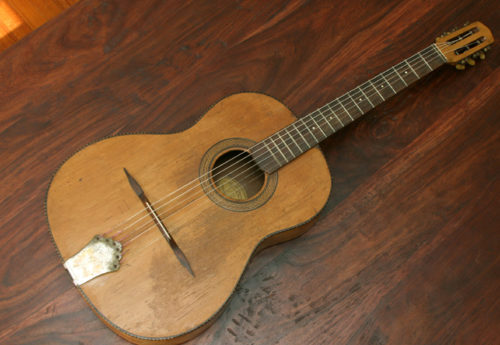 When Martin entered into its “Golden Age” for the flat top guitar, the jazz guitar was evolving on a parallel and equally important track. And in Europe, especially France, they had their own ideas about guitar making, and produced some brilliant guitars in this era–including of course the wonderful Selmer gypsy jazz guitar. The brothers Gerome were among the best luthiers in Mirecourt, France, a city famous in Europe for producing the finest gypsy and jazz guitars, in the 20s, 30s, and 40s. This all original, gypsy style guitar has maple back and sides, to give that high, twangy tone, just what you want in a django-style guitar. This one has loud piercing trebles–the treble strings are louder and more piercing than any guitar of any kind I have ever heard. Only maple produces that loud sharp treble. The volume of this instrument is striking, and there is almost a “reverb”, resonant quality to the tone. Solid spruce top. Black & white checkerboard marquetry binding on top, and rosette. It has a very thick rosewood fingerboard (over 4/10 inches/10.5mm thick!) Maple neck. Nut just shy of 1 7/8 inch. Wonderful bakelite buttons on the tuners. And it would not be a genuine gypsy jazz classic, if it did not have the hallmarks of this style: the original “floating bridge”–not an “adjustable brigde” for height, but a floating rosewood bridge that is not glued to the top, but held on by string tension (the “wings” of the bridge are glued to the top in this configuration). (You can of course change the intonation with this set-up.) The other feature that is a must, is the “zero fret”, i.e. there is a fret (the “zero” fret) right in front of the nut. 14-5/8 inch wide at lower bout. All original finish. A couple of small cracks on top. Top center seam repair. Original T-frets show wear, but still work fine. No buzzing. Action is good. Takes loop-end strings (available from many sources–Savarez Argentine strings are great on this instrument).
When Martin entered into its “Golden Age” for the flat top guitar, the jazz guitar was evolving on a parallel and equally important track. And in Europe, especially France, they had their own ideas about guitar making, and produced some brilliant guitars in this era–including of course the wonderful Selmer gypsy jazz guitar. The brothers Gerome were among the best luthiers in Mirecourt, France, a city famous in Europe for producing the finest gypsy and jazz guitars, in the 20s, 30s, and 40s. This all original, gypsy style guitar has maple back and sides, to give that high, twangy tone, just what you want in a django-style guitar. This one has loud piercing trebles–the treble strings are louder and more piercing than any guitar of any kind I have ever heard. Only maple produces that loud sharp treble. The volume of this instrument is striking, and there is almost a “reverb”, resonant quality to the tone. Solid spruce top. Black & white checkerboard marquetry binding on top, and rosette. It has a very thick rosewood fingerboard (over 4/10 inches/10.5mm thick!) Maple neck. Nut just shy of 1 7/8 inch. Wonderful bakelite buttons on the tuners. And it would not be a genuine gypsy jazz classic, if it did not have the hallmarks of this style: the original “floating bridge”–not an “adjustable brigde” for height, but a floating rosewood bridge that is not glued to the top, but held on by string tension (the “wings” of the bridge are glued to the top in this configuration). (You can of course change the intonation with this set-up.) The other feature that is a must, is the “zero fret”, i.e. there is a fret (the “zero” fret) right in front of the nut. 14-5/8 inch wide at lower bout. All original finish. A couple of small cracks on top. Top center seam repair. Original T-frets show wear, but still work fine. No buzzing. Action is good. Takes loop-end strings (available from many sources–Savarez Argentine strings are great on this instrument). -
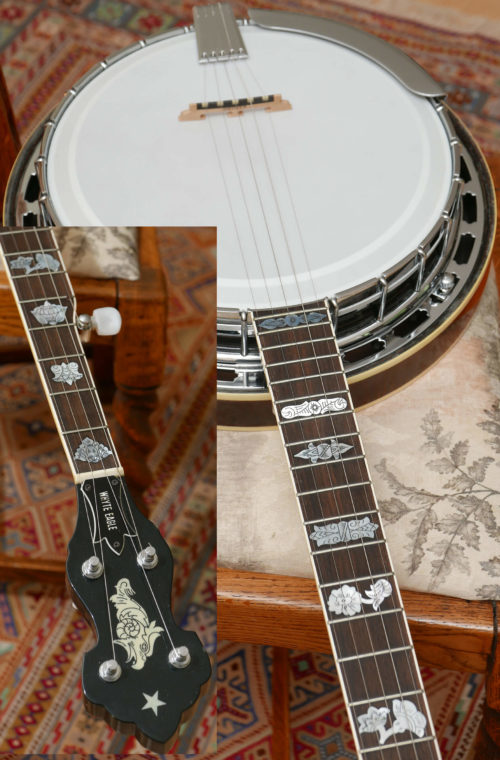 Early 1970s, but in remarkably original condition. And this instrument is from the first, early production– so it has the maple 3-ply rim. This should not be compared to later production Whyte Eagles– this is a very rare early one with unique features, and great tone. This banjo design is based on: • neck/head/inlays: based on the high end Fairbanks Whyte Ladye of the early 20th century– one of the most beautiful designs in banjo history • the pot assembly is modeled closely on the Gibson TB3, archtop of the 1930's. In fact it's a remarkable recreation of that design (and sound) – a more faithful recreation that many Gibson post-war versions. Bluegrass banjo players seek out the 70’s Alvarez Whyte Eagles, known for their tone and craftsmanship. It was a pretty short window of only about five years, when these banjos were made with this kind of craftsmanship. They blow away most any banjo made and marketed (from any country) in the 60s, 70s and 80s– and they show no logos on headstock– just beautiful mother of pearl. It’s the No. 4310 “Whyte Eagle”. Based on late 1920’s Vega Griffin (Tubaphone #9) style inlays, with engraved, carved heel. Sunburst finish maple banjo, Gibson-style 2 piece flange, full height 20 hole archtop tone ring, dual coordinator rods, flamed maple resonator, maple neck, chrome finish. Neck is butterfly with ebony strip on back of neck, down the center. It’s extremely rare to find a Whyte Eagle from this very early period (serial number 1672), when they first came out and the company bent over backwards to produce an instrument with zero compromise, from the inlays to the maple rim. The early features that are not on the later 70's Whyte Eagles, are– in addition to the 3-ply maple rim (not the 10-ply rim of almost all other Whyte Eagles)– the smaller star on the front of headstock (later models had a larger star), no “Alvarez” logo just the eagle inlay, and a darker sunburst on the resonator and also on the back of the neck. Flamed maple resonator (sunburst back, with a touch of milkiness to the original finish) Maple butterfly neck Hand-carved heel Mother of pearl inlays Original tuners Grover bridge 1 3/16 nut Scale: 26 ¼ inches 20 hole archtop tone ring 11 inch head ... no longer available ...
Early 1970s, but in remarkably original condition. And this instrument is from the first, early production– so it has the maple 3-ply rim. This should not be compared to later production Whyte Eagles– this is a very rare early one with unique features, and great tone. This banjo design is based on: • neck/head/inlays: based on the high end Fairbanks Whyte Ladye of the early 20th century– one of the most beautiful designs in banjo history • the pot assembly is modeled closely on the Gibson TB3, archtop of the 1930's. In fact it's a remarkable recreation of that design (and sound) – a more faithful recreation that many Gibson post-war versions. Bluegrass banjo players seek out the 70’s Alvarez Whyte Eagles, known for their tone and craftsmanship. It was a pretty short window of only about five years, when these banjos were made with this kind of craftsmanship. They blow away most any banjo made and marketed (from any country) in the 60s, 70s and 80s– and they show no logos on headstock– just beautiful mother of pearl. It’s the No. 4310 “Whyte Eagle”. Based on late 1920’s Vega Griffin (Tubaphone #9) style inlays, with engraved, carved heel. Sunburst finish maple banjo, Gibson-style 2 piece flange, full height 20 hole archtop tone ring, dual coordinator rods, flamed maple resonator, maple neck, chrome finish. Neck is butterfly with ebony strip on back of neck, down the center. It’s extremely rare to find a Whyte Eagle from this very early period (serial number 1672), when they first came out and the company bent over backwards to produce an instrument with zero compromise, from the inlays to the maple rim. The early features that are not on the later 70's Whyte Eagles, are– in addition to the 3-ply maple rim (not the 10-ply rim of almost all other Whyte Eagles)– the smaller star on the front of headstock (later models had a larger star), no “Alvarez” logo just the eagle inlay, and a darker sunburst on the resonator and also on the back of the neck. Flamed maple resonator (sunburst back, with a touch of milkiness to the original finish) Maple butterfly neck Hand-carved heel Mother of pearl inlays Original tuners Grover bridge 1 3/16 nut Scale: 26 ¼ inches 20 hole archtop tone ring 11 inch head ... no longer available ... -
Out of stock
 This guitar is a masterfully crafted interpretation of the fabled Roy Smeck, a slope-shouldered Gibson acoustic from the 1930s, which pairs a 12-fret neck with a standard, slope shouldered body, in Brazilian rosewood. From Charlottesville, Virginia-based Rockbridge -- one of the country’s most intriguing and masterful boutique luthiers. In a custom Cedar Creek case. Read the full description below. If you're interested in this guitar, please call 512.922.8596 or contact us here.
This guitar is a masterfully crafted interpretation of the fabled Roy Smeck, a slope-shouldered Gibson acoustic from the 1930s, which pairs a 12-fret neck with a standard, slope shouldered body, in Brazilian rosewood. From Charlottesville, Virginia-based Rockbridge -- one of the country’s most intriguing and masterful boutique luthiers. In a custom Cedar Creek case. Read the full description below. If you're interested in this guitar, please call 512.922.8596 or contact us here. -
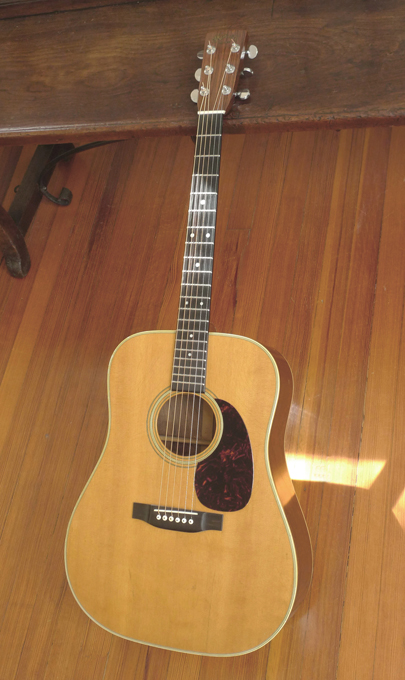 Very Nice Brazilian Rosewood D-28 dreadnaught.
Very Nice Brazilian Rosewood D-28 dreadnaught.- All original finish, bridge, bridge plate, tuners
- Newer saddle and nut, just installed to give perfect action, tone
- Original Tortoise pickguard
- Original small maple bridge plate, great condition
- Typical small “pickguard crack” as almost vintage Martins with pickguards have. It was professionally closed/glued years ago, stable and no longer an issue. There is a 4 2/3 inch finish crack, with 2 inches or so of that just barely visible from inside– located from edge of lower bout up, about 3 inches to the treble side of the center seam… professionally closed/glued years ago, stable and not an issue now
- Brazilian Rosewood back and sides: crack-free
- 100% original finish, everywhere. No overspray or finish alterations of any kind. Minor dings and some minor pickwear around the soundhole.
- Has never had a strap lug attached to the wood of the heel itself. There is a strap lug attached to the ivoroid heel cap.
- Original frets are in great condition… just a bit of wear, on frets 1-3/B string only
- Action is great– low and fast and loud, and neck angle is fine. Plenty of saddle left.
- Typical crazing of finish on top and back as seen on almost all mid-60s Martins (finish is all original, everywhere)
-
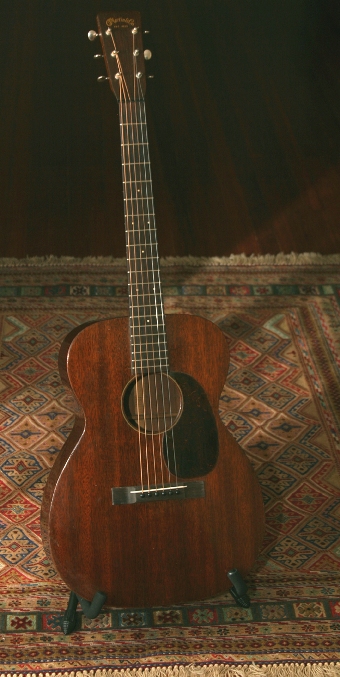 This model is something of a sleeper on the Golden Era Martin guitar market, because there are just not that many pre-1939 00-17s available. There are quite a few war-time and post-war 00-17s, but a 00-17 with full pre-war specs, forward shifted X-bracing, and 1 3/4 inch nut, is hard to come by–and they have all the great qualities of 00-sized Golden Era Martins that cost twice or three times the price on the vintage market–for now, as these great pre-war 00-17s will catch up quickly. The tone and volume of this 00-17 is astounding: full, amazingly bright, and with impressive volume. 1-3/4 inch nut width. Crack-free except for a well-repaired crack on bass side, about 2 inches long, that's difficult to see even up close. No cracks at all on top, or back. All original finish. Original bridge plate. This model has of course a mahogany top as well as mahogany back and sides. And with that dark look and original gloss finish that really sets this Golden Age Martin apart in its own class. Neck has the typically slightly beefier profile that's the hallmark of the best 30's 14-fret Martins. Neck was set by us. Replaced, period-correct Brazilian rosewood bridge. Original ebony nut. All new T-frets installed by us. Original tuners.
This model is something of a sleeper on the Golden Era Martin guitar market, because there are just not that many pre-1939 00-17s available. There are quite a few war-time and post-war 00-17s, but a 00-17 with full pre-war specs, forward shifted X-bracing, and 1 3/4 inch nut, is hard to come by–and they have all the great qualities of 00-sized Golden Era Martins that cost twice or three times the price on the vintage market–for now, as these great pre-war 00-17s will catch up quickly. The tone and volume of this 00-17 is astounding: full, amazingly bright, and with impressive volume. 1-3/4 inch nut width. Crack-free except for a well-repaired crack on bass side, about 2 inches long, that's difficult to see even up close. No cracks at all on top, or back. All original finish. Original bridge plate. This model has of course a mahogany top as well as mahogany back and sides. And with that dark look and original gloss finish that really sets this Golden Age Martin apart in its own class. Neck has the typically slightly beefier profile that's the hallmark of the best 30's 14-fret Martins. Neck was set by us. Replaced, period-correct Brazilian rosewood bridge. Original ebony nut. All new T-frets installed by us. Original tuners. -
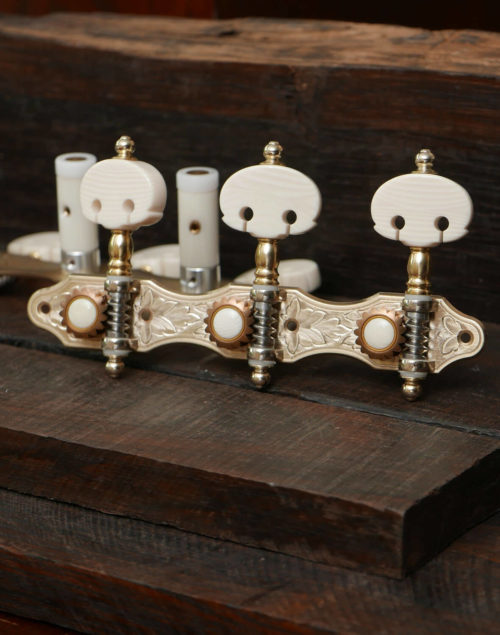 Alessi, Hauser style machine head tuners. More rare, deep silver plating. Hand made in Italy. Engraved with high detail. These are new, old stock. Made circa 2009, they have never been used or mounted on a guitar, and they come with the original mounting screws, and in their original wood presentation case. Synthetic ivory kidney shaped buttons (rare style). 35mm on center. Perfect, unused condition. Price: $895.
Alessi, Hauser style machine head tuners. More rare, deep silver plating. Hand made in Italy. Engraved with high detail. These are new, old stock. Made circa 2009, they have never been used or mounted on a guitar, and they come with the original mounting screws, and in their original wood presentation case. Synthetic ivory kidney shaped buttons (rare style). 35mm on center. Perfect, unused condition. Price: $895. -
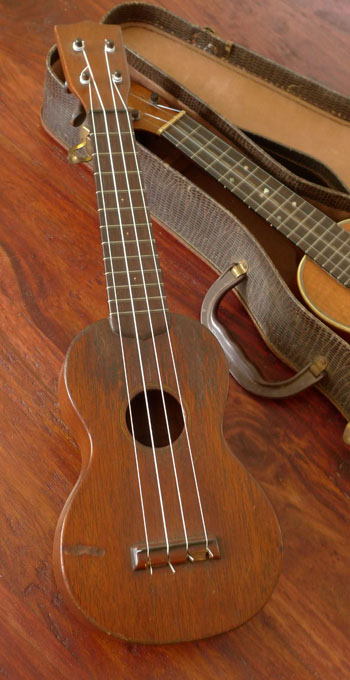 A pre-decal Uke from Martin. Style 0, with no body binding. Well worn, but 100% crack free.
A pre-decal Uke from Martin. Style 0, with no body binding. Well worn, but 100% crack free. -
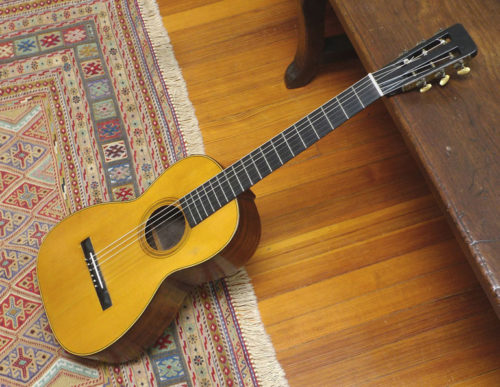 This guitar is the last known guitar in existence, made by Louis Schmidt, the famous contemporary and one-time colleague to the founder of Martin Guitars, the original C.F. Martin. As such, it is a rare example of early American guitar making. And it’s signed by the maker, on the underside of the Adirondack top: Louis Schmidt Wakefield Westchester Cy NY July 9th 1859 U.S. Louis Schmidt worked side by side with CF Martin in the early years. Perhaps the most common misconception about early American guitar history is that C. F. Martin spent his first years in America earning a living as a solitary luthier in his New York workshop. Pay ledgers reveal that as early as 1834 he was paying luthiers to help him make his guitars. Two of these men, Heinrich Schatz and Louis Schmidt, left Martin's employ to make guitars on their own, and each succeeded as top builders. This instrument:
This guitar is the last known guitar in existence, made by Louis Schmidt, the famous contemporary and one-time colleague to the founder of Martin Guitars, the original C.F. Martin. As such, it is a rare example of early American guitar making. And it’s signed by the maker, on the underside of the Adirondack top: Louis Schmidt Wakefield Westchester Cy NY July 9th 1859 U.S. Louis Schmidt worked side by side with CF Martin in the early years. Perhaps the most common misconception about early American guitar history is that C. F. Martin spent his first years in America earning a living as a solitary luthier in his New York workshop. Pay ledgers reveal that as early as 1834 he was paying luthiers to help him make his guitars. Two of these men, Heinrich Schatz and Louis Schmidt, left Martin's employ to make guitars on their own, and each succeeded as top builders. This instrument:- Similar features to circa 1860 Martin 17 style... but different purfling, binding, and slightly different body shape
- All original finish
- Brazilian rosewood back and sides (solid); Adirondack top
- In its original coffin case
- 11 3/8 inches wide at lower bout (a bit larger than a Martin 2 1/2)
- Body: 3 7/8 inches deep
- Original mahogany bridge plate (goes almost all the way across the width of the top, slotted under all the braces)
- Fan bracing pattern
- Plays beautifully. Good bass tone. Action is perfect.
- Ebony Bridge has been off at some point, and reglued on. With a lack of similar guitars on the market, it’s not known if this 19th century bridge on the instrument is the original bridge.
- One repaired crack on top, from bridge to bottom binding; One repaired crack on back. One small crack on top, either top edge of soundhole.
- Original Jerome tuners, reverse gear, working perfectly
- Maple and rosewood purfling/binding on top (no binding on back)
-
 Nothing sounds like a 30’s Gibson L-00. No longer a sleeper on the vintage guitar market–they are sought after by working musicians the world over¬–they are still under-rated on the collector market. These mid-size Gibsons are incredibly resonant. There is nothing like them, from Gibson, and the mid-size Adirondack spruce over mahogany Martins from the mid to late 30’s command more than twice the price. This L-00 from 1938 has the best tone of any of the 30’s L-00’s we’ve seen. You won’t believe its presence. Acquired by us from the family of the original owner in Austin, Texas, this guitar is a great example of the era when Gibson still had a production jump on Martin, and even its lower cost guitars were winning the marketing war at the trailing end of the depression. This L-00 had a re-spray of its burst in the early 60’s, so while not the original finish, it’s got the right look and feel of the 30’s, and plenty of mileage to make it more than convincing. The top and sides are completely crack-free, and there are only two small cracks on the back. One is not through the wood, and the other was expertly addressed by Tony Nobles with a small cleat. Tony also made a new perfect reproduction Brazilian Rosewood bridge. The bridge plate is original and in great condition. Original firestripe pickguard. Original nut. The non-original tuners on the instrument when we acquired it were replaced by us with klusons from the period. Tony also installed new T-frets. While we tend to specialize in vintage Martins, this one might change my mind.
Nothing sounds like a 30’s Gibson L-00. No longer a sleeper on the vintage guitar market–they are sought after by working musicians the world over¬–they are still under-rated on the collector market. These mid-size Gibsons are incredibly resonant. There is nothing like them, from Gibson, and the mid-size Adirondack spruce over mahogany Martins from the mid to late 30’s command more than twice the price. This L-00 from 1938 has the best tone of any of the 30’s L-00’s we’ve seen. You won’t believe its presence. Acquired by us from the family of the original owner in Austin, Texas, this guitar is a great example of the era when Gibson still had a production jump on Martin, and even its lower cost guitars were winning the marketing war at the trailing end of the depression. This L-00 had a re-spray of its burst in the early 60’s, so while not the original finish, it’s got the right look and feel of the 30’s, and plenty of mileage to make it more than convincing. The top and sides are completely crack-free, and there are only two small cracks on the back. One is not through the wood, and the other was expertly addressed by Tony Nobles with a small cleat. Tony also made a new perfect reproduction Brazilian Rosewood bridge. The bridge plate is original and in great condition. Original firestripe pickguard. Original nut. The non-original tuners on the instrument when we acquired it were replaced by us with klusons from the period. Tony also installed new T-frets. While we tend to specialize in vintage Martins, this one might change my mind. -
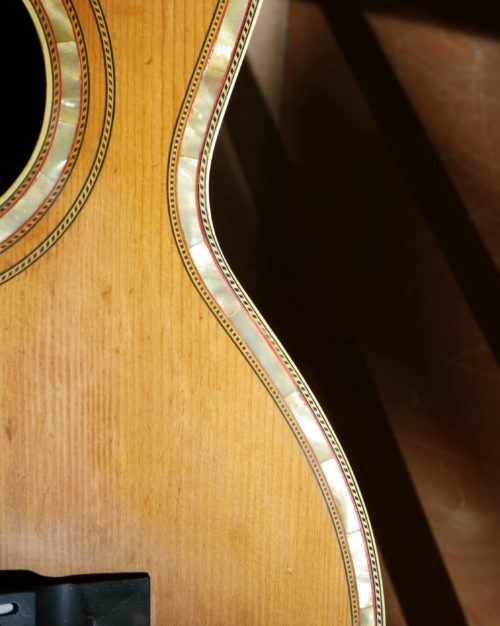 Circa 1912 Mother of Pearl Inlaid Guitar The guitar is extensively inlayed with mother of pearl . The guitar was restored in 2001, work that included converting the instrument to X-bracing, reproduction ebony bridge, reproduction small maple bridge plate. It’s signed inside by the restorer, “B. Lehmann 2001” (Bernie Lehmann, well known luthier in New York.) The guitar has no stamps or labels, but it was probably made by George Bauer – because of many stylistic similarities. The guitar is set up and ready to play. As many guitars of this era, the tone is tilted toward very bright, glassy, brazilian rosewood trebles, not fuller bass. Solid Spruce top Solid Brazilian Rosewood back and sides MOP inlays, fretboard, rosette, and bindings X-braced Original tuners Width at lower bout: 13 1/2 inches Scale Length: 24 7/8 inches Nut Width: 1 ¾ inches V shaped neck .... no longer available....
Circa 1912 Mother of Pearl Inlaid Guitar The guitar is extensively inlayed with mother of pearl . The guitar was restored in 2001, work that included converting the instrument to X-bracing, reproduction ebony bridge, reproduction small maple bridge plate. It’s signed inside by the restorer, “B. Lehmann 2001” (Bernie Lehmann, well known luthier in New York.) The guitar has no stamps or labels, but it was probably made by George Bauer – because of many stylistic similarities. The guitar is set up and ready to play. As many guitars of this era, the tone is tilted toward very bright, glassy, brazilian rosewood trebles, not fuller bass. Solid Spruce top Solid Brazilian Rosewood back and sides MOP inlays, fretboard, rosette, and bindings X-braced Original tuners Width at lower bout: 13 1/2 inches Scale Length: 24 7/8 inches Nut Width: 1 ¾ inches V shaped neck .... no longer available.... -
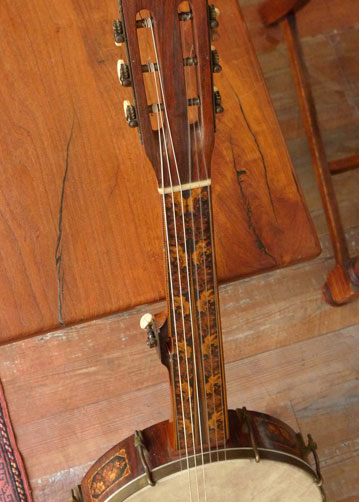 Read the full description below. If you're interested in this guitar, please call 512.922.8596 or contact us here.
Read the full description below. If you're interested in this guitar, please call 512.922.8596 or contact us here.